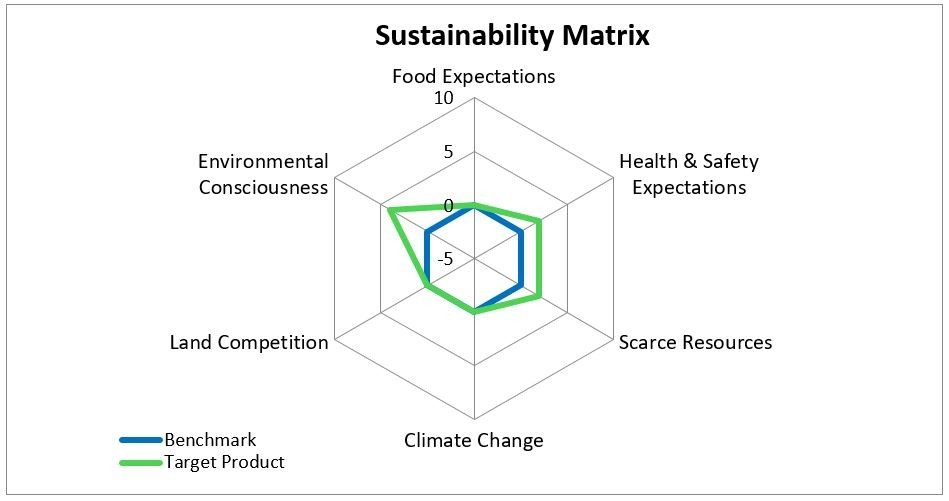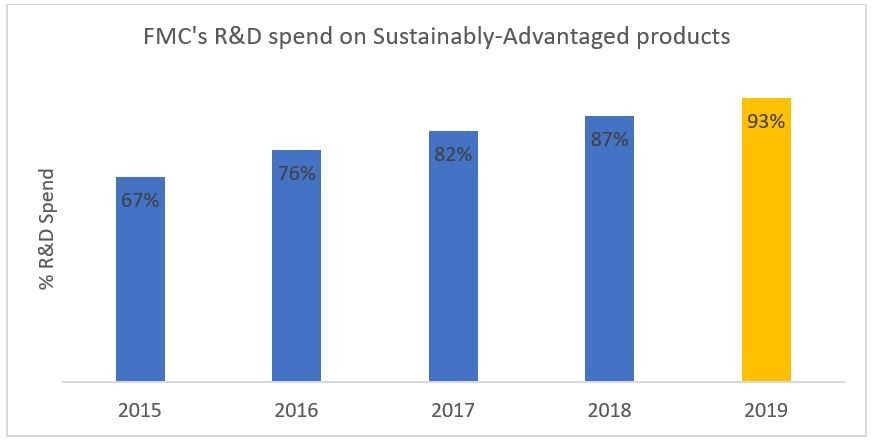By: Linda W. Froelich, FMC Corporation, Director, Corporate Sustainability

At FMC, we are committed to developing products and technologies for a secure and sustainable food supply.
Science and innovation drive our business. We invest significant resources in discovering new active ingredients and formulations that support sustainable agriculture around the world. Our R&D team of more than 800 scientists and associates are working on one of the most robust discovery and development pipelines in the industry. Recognizing the work in R&D as a core part of our business, we sought to think of ways that we could measure and evaluate R&D projects and our existing products in the market through the lens of sustainability. In 2016, we developed the Product Stewardship and Sustainability Assessment Tool (PSSA).
What is the PSSA tool?
The PSSA is an American Chemistry Council (ACC) award-winning tool that compares an active ingredient or formulated product to a benchmark active ingredient or product. This results in a sustainability matrix value and a spider diagram (see example below) that determine if our project or product is more sustainable than the benchmark. This matrix value is based on stewardship and sustainability questions that address product hazards, environmental and human exposure and the product’s overall life cycle.
The questions in the PSSA focus on six major global challenges and directly relate the ACC’s industry-wide Sustainability Principles. These global challenges are:
Food Expectations: This challenge recognizes the need for increased crop yields, sustainable agriculture, better control of significant crop pests, more effective control of known resistant pests, new modes of action that delay resistance, or is useful for integrated pest management and reduced residues in food.
Health and Safety Expectations: This challenge recognizes the need for reduced worker exposure, control of pests known to negatively impact human health, or safer inert ingredients.
Scarce Resources: This challenge recognizes the need to reduce the environmental footprint in production and in the use phase of the product.
Climate Change: This challenge recognizes the need to reduce greenhouse gas emissions, help crops adapt to higher temperatures, reduce time to harvest or improve consistency of yield.
Land Competition: This challenge recognizes the need to reduce drift, increase farming in arid areas or areas of poor soil quality, improve soil quality, promote integrated crop management, or promote crop rotation.
Environmental Consciousness: This challenge recognizes the need to reduce application rates, reduce impact on wildlife, endangered or beneficial species, reduce water contamination, reduce the number of applications, reduce soil and water residues, or formulate products for precision farming.
An R&D project or product is considered sustainable if it is better than the benchmark in at least one of the six global challenges, but it cannot retreat in any of the five other areas. If a product is not considered sustainable because its attributes are not as good as the benchmark, then FMC works to mitigate the area of concern.
This tool is used as a part of the R&D stage gate process for new active ingredients and is also used to regularly evaluate products currently on the market. This assessment, along with other stewardship processes and tools, ensures the introduction and continued use of environmentally sustainable agricultural solutions.
Sustainability Matrix

The PSSA tool also contributes to three of the United Nations Sustainable Development Goals:
SDG #2 Zero Hunger: ensures that FMC develops and promotes safe and environmentally sustainable products to increase the world food supply and increase food security.
SDG #13 Climate Action: ensures that FMC continually evaluates its products throughout their life cycle with a focus on reducing our environmental footprint.
SDG #15 Life on Land: ensures that FMC develops and promotes products that increase crop yields and sustainable agriculture on current production lands and that these products do not negatively affect the cropland where they are used.
The PSSA Tool in Practice
FMC has a public sustainability goal stating that 100 percent of our R&D spending will be focused on developing sustainably advantaged products by 2025. As described above, the PSSA tool is used to evaluate active ingredients and formulated products in the R&D pipeline to see how we are progressing towards this goal. As indicated in the bar graph below, we have continually increased this percentage year over year. In 2019, 93 percent of our R&D spending was focused on developing sustainably advantaged products.
FMC's R&D spend on Sustainably-Advantaged products

We evaluate the effectiveness of the PSSA on an annual basis to make sure the questions are clear, relevant and effective. In addition, we review the benchmark active ingredients and formulated products used for comparison to be sure they are relevant. This ensures we are continually improving our crop protection products regarding worker/applicator safety, crop yields, process chemistry and environmental footprint.
The PSSA provides us with a very comprehensive understanding of our products in relation to our overall stewardship and sustainability programs. This process has facilitated a greater knowledge transfer to our external stakeholders, including customers, distributors, investors and regulators. It also helps in sharing our vision of stewardship and sustainability to meet the growing needs of a growing world.
FMC has openly shared the PSSA tool and its methodology on our external sustainability website and with peer companies so that the agricultural industry and other industries can benefit from it. This open approach facilitates sustainable processes across companies and will help continually improve the safety, sustainability and stewardship of all products to help feed the world and ensure a secure food supply.
This article has been edited for length and clarity. The opinions expressed in this article are the author's own and do not necessarily reflect the view of their employer or the American Chemical Society.
Copyright 2022 American Chemical Society (All Rights Reserved)





